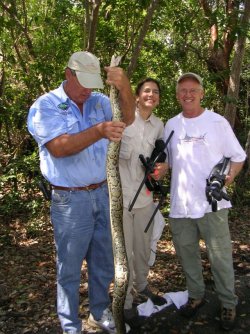Researcher’s find sparks major python hunt
A major python hunt is underway in Florida after a University of St Andrews researcher literally stumbled upon a ferocious eight foot snake.

Joanne Potts discovered the python while tracking endangered woodrats in Key Largo. The snake was only found because it was transmitting a signal from the woodrat it had eaten. By consuming one of the area’s most protected species, the python’s discovery has prompted a major hunt for more, and governmental discussions on how to keep others at bay.
Joanne, a PhD student at the University’s Centre for Research into Ecological and Environmental Modelling (CREEM), found the snake in the woods of Dagny Johnson Key Largo Hammock Botanical State Park last month. It is thought to be the first Burmese python spotted in Key Largo, although they have been found in the Everglades and are often found as roadkill on mainland Florida.
Despite claims it could have been an escaped pet, Joanne believes that the python was wild and posed a serious threat to endangered species.
“The python was very aggressive, behaviour not observed in captive reared individuals as they are familiar with being handled by humans. It was also in very good condition and was well fed on wild animals, again not usually seen in captive reared individuals, because they typically don’t know how to hunt and often die shortly after being released into the wild. They are extremely good swimmers so may simply have made the journey from the mainland”.
The implications of the discovery are massive.
Joanne said, “Northern Key Largo is home to numerous endemic and critically endangered species, including the Key Largo woodrat and Key Largo cotton mouse. Both of these rodents could very easily become extinct if the python has an established population there. Pythons are ferocious predators. They literally sit and wait until an animal wanders by, and then eat it. Pythons (unlike all other native snakes in the area) will eat until they are literally jam-packed full with rats and mice. The fact that this python was found to contain two woodrats gives an indication of the amount of food required to maintain such a snake”.
The finding has led to a massive survey to determine the existence of others, including the establishment of a ‘python hotline’. In addition, precautionary measures are being investigated, such as installing drift fences to prevent more pythons dispersing further down the Keys.
ENDS
NOTE TO EDITORS
Joanne Potts available today (Tuesday 5 May 2007) – telephone 01334 461824.
Image available via University of St Andrews Press Office – contact details below.
Issued by Press Office, University of St Andrews
Contacts:
Claire Grainger, Press Officer – 01334 462530, 07730 415 015 or email [email protected]
Gayle Cook, Press Officer – 01334 462529, 07900 050 103 or email [email protected]
Ref: python
View the latest University press releases at http://www.st-andrews.ac.uk
Category Public interest stories